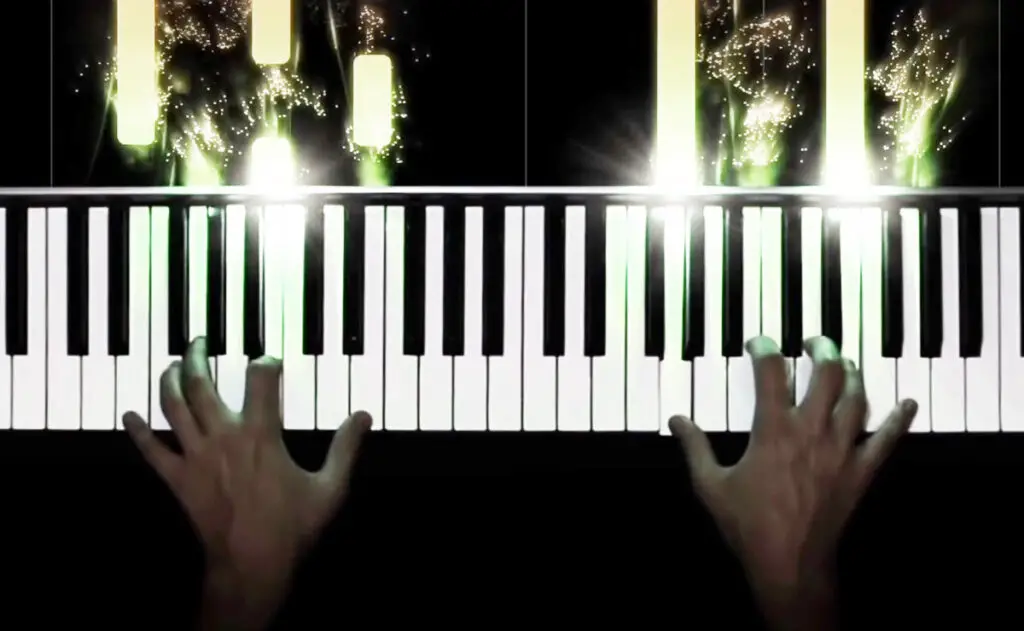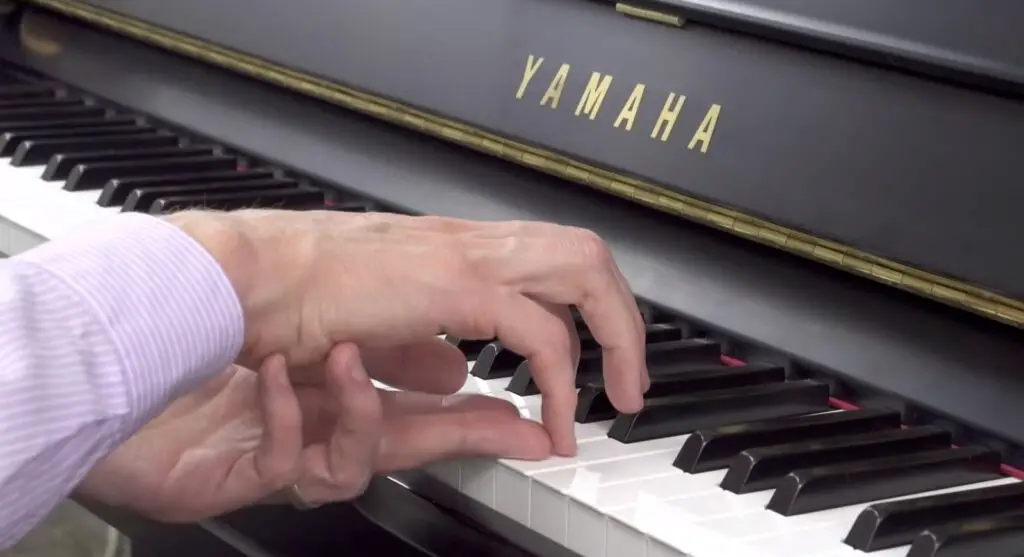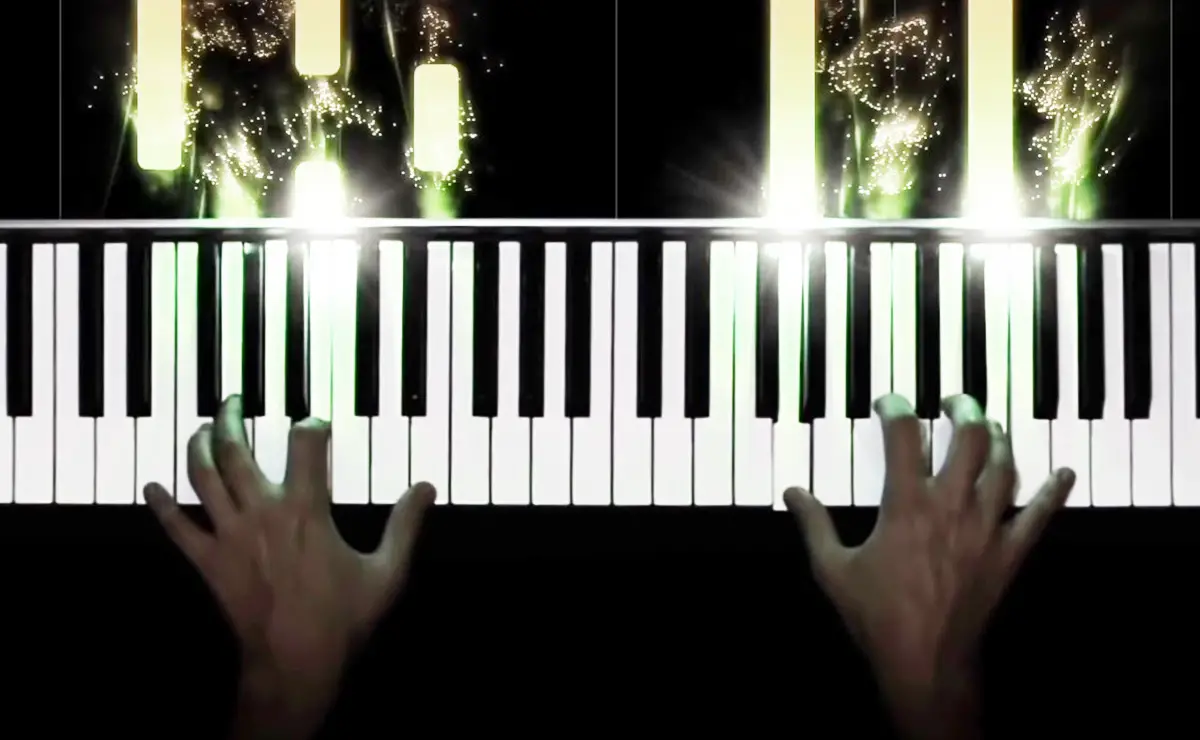Mastering the piano is a journey of beautiful discovery that can span a lifetime. One of the enchanting yet challenging aspects of this journey is learning to play harmoniously with both hands.
How do you get better at playing piano with both hands?
Improving your ability to play the piano with both hands requires consistent, focused practice on scales, arpeggios, and pieces, starting slowly and gradually increasing speed, as well as breaking down complex sections to practice each hand separately before combining them.
Consider using a metronome for maintaining rhythm, and if possible, seek guidance from a qualified piano teacher.
This ability transforms simple melodies into rich, complex music, and it’s a skill that all pianists strive to master. Whether you’re a beginner starting to explore this new territory, or an intermediate player wanting to enhance your hand coordination, this article is for you.
Related Content: Pianist Hands Vs Normal Hands: What Are Piano Hands?
We will explore hand independence and effective techniques, share practical exercises, and offer expert tips on how to get better at playing piano with both hands.
It may seem daunting at first, but with patience, practice, and perseverance, you will unlock a whole new level of musical expression. So, let’s embark on this exciting adventure together!

How Do You Play The Piano With Both Hands?
Playing the piano with both hands involves learning to perform different tasks with each hand simultaneously. Here is a basic guide to start:
- Understand the Piano Layout: The piano keyboard is made up of white and black keys, with the white keys representing the natural notes (A, B, C, D, E, F, G) and the black keys representing the sharps and flats. The pattern of white and black keys repeats every octave.
- Basic Hand Positioning: Each finger is generally assigned a number, with the thumb being 1 and the pinky being 5. For both hands, the thumb (1) is placed on middle C, with the rest of the fingers placed on the consecutive white keys (D, E, F, G). This is a very basic hand positioning called the C position.
- Practice with Each Hand Separately: Before you can play with both hands, you need to be comfortable with each hand individually. Start with simple scales and exercises, like the C Major scale. Practice until you can play smoothly and consistently.
- Slowly Introduce Both Hands: Once you’re comfortable with each hand separately, start practicing with both hands. This can be challenging at first, because each hand might be playing something different. Start with simple exercises where both hands play the same notes at the same time, and gradually move to exercises where the hands play different notes.
- Learn to Read Sheet Music: As you progress, you’ll want to learn to read sheet music. Piano sheet music is written on the grand staff, which consists of two staves (or sets of five lines). The upper staff, usually in treble clef, represents the notes played with the right hand, and the lower staff, usually in bass clef, represents the notes played with the left hand.
Learn How to Find and Read Notes Here. - Practice Regularly: As with any skill, regular practice is key to improvement. Set aside time each day to practice, and try to maintain a consistent schedule.
- Get a Piano Teacher: If possible, consider getting a piano teacher. A teacher can provide personalized guidance and catch any mistakes that you might not notice on your own.
Playing the piano is a complex skill that takes time to learn. Don’t get discouraged if progress seems slow – keep practicing, and you’ll continue to improve!
Why Is It So Hard To Play The Piano With Both Hands?
Playing the piano with both hands is challenging for several reasons:
- Hand Independence: The main difficulty lies in the need for hand independence, which is the ability to perform different actions with each hand simultaneously. This is not something we typically do in our daily lives, so it requires a lot of practice to develop.
- Different Roles of Each Hand: In most piano music, the right hand usually plays the melody, while the left hand provides the accompaniment. This often means that each hand is playing different rhythms and different notes, which can be difficult to coordinate.
- Reading Two Lines of Music Simultaneously: Piano music is written on two staves (the treble clef for the right hand and the bass clef for the left hand). Reading and interpreting two lines of music at the same time is a complex cognitive task.
- Physical Coordination and Dexterity: Playing the piano requires fine motor skills and coordination, which can take time to develop. You need to be able to move your fingers independently and accurately hit the keys.
- Mental Load: When playing the piano, you need to focus on many things at once: reading the music, coordinating your hands, listening to the sound you’re producing, and planning ahead for the next notes. This multitasking can be mentally challenging.
- Musicality: Beyond just playing the correct notes, you also need to think about expression, phrasing, dynamics, and timing. Adding this layer of musicality while managing the technical aspects can be difficult.
With consistent practice and patience, these challenges can be overcome. Each difficulty you face and conquer in learning to play the piano with both hands helps to develop your musical skills and understanding.
Playing the piano involves hand coordination and dexterity. Learn about the physical benefits of playing the piano.
How To Get Better At Playing Piano With Both Hands
Improving your ability to play the piano with both hands requires patience, practice, and good technique. Here are some tips to help you improve:
- Start Slow: When learning a new piece, start by playing it very slowly. This will help you understand the coordination between your hands without feeling rushed. As you become more comfortable, gradually increase the tempo.
- Practice Hands Separately: Break down difficult sections and practice them with one hand at a time. Once you feel confident with each hand separately, try combining them.
- Simplify: If a piece is too difficult to play with both hands, simplify it. This could mean leaving out some notes or playing fewer octaves. Once you can play the simplified version, slowly start adding in the complexity.
- Use a Metronome: A metronome can help you keep a steady tempo, which is especially helpful when you’re trying to coordinate both hands. Start with a slow tempo and gradually increase it as you become more comfortable.
- Practice Scales and Arpeggios: Scales and arpeggios can help improve your finger dexterity and hand coordination. Practice them with both hands, both separately and together.
- Try Different Styles of Music: Different styles of music require different types of hand coordination. For example, playing jazz might require more hand independence than playing classical music. Experimenting with different styles can help improve your overall skill.
- Consistent Practice: Consistency is key when learning a new skill. Try to set aside time each day to practice and focus on improving a little bit each time.
- Consider a Piano Teacher: A good piano teacher can provide valuable feedback and help you improve more quickly. They can identify areas where you’re struggling and suggest exercises to help you improve.
- Patience: Developing coordination between your hands is a complex skill that takes time to learn. Don’t be discouraged if progress seems slow. Remember that every bit of practice helps you improve.
Everyone learns at their own pace, so it’s important to be patient with yourself and celebrate your progress along the way.
As you improve at playing piano, you should be improving your music theory as well. My music theory lessons begin with What is Music? and What is a Music Note?

How Long Does It Take To Play Piano With Both Hands?
The length of time it takes to play the piano with both hands proficiently varies greatly depending on a number of factors, such as:
- Previous Musical Experience: If you already play another instrument or can read music, you may learn to play the piano more quickly.
- Frequency and Quality of Practice: The more regularly and effectively you practice, the faster you will improve. Practicing for a focused 30 minutes every day is more beneficial than practicing for a few hours once a week.
- Complexity of the Music: You might be able to play a simple melody with one hand and accompany it with basic chords in the other within a few weeks or months of starting. However, playing more complex pieces or styles of music that require a high degree of hand independence can take years of study.
- Personal Factors: Everyone learns at their own pace. Age, natural aptitude, motor skills, and determination all play a role in how quickly you can learn to play the piano.
- Instruction: Having a good piano teacher can significantly speed up the learning process. A teacher can provide feedback, correct mistakes, and guide your practice effectively.
As a rough estimate, with regular practice and instruction, a complete beginner might be able to play simple songs with both hands after a few months of learning. More complex pieces will take longer, and gaining a high level of proficiency can take several years.
The most important thing is to enjoy the journey of learning and not rush the process. Playing an instrument is a lifelong journey, and there is always more to learn.
Are Pianists Ambidextrous?
While playing the piano does involve using both hands and often requires each hand to perform different tasks, this does not necessarily make pianists ambidextrous in the general sense of the term.
Ambidexterity is the ability to use both the right and left hand equally well in all tasks. Most people, including many pianists, have a dominant hand that they use for most tasks.
However, pianists do develop a high degree of skill and independence in both hands through their practice of the instrument.
They are able to perform complex and different tasks with each hand simultaneously, which could be considered a form of “musical ambidexterity.” This is a skill that is developed through years of practice and is specific to playing the piano or other keyboard instruments.
So while pianists may not generally be ambidextrous in all tasks, they do develop a specialized form of ambidexterity in relation to their instrument.
How Do I Improve My Hand Dexterity On Piano?
Improving your hand dexterity on the piano involves several strategies:
- Scales and Arpeggios: Regularly practicing scales and arpeggios is one of the most effective ways to improve your hand dexterity. They help to build finger strength and independence, as well as improve your understanding of key signatures.
- Technical Exercises: There are many books of technical exercises designed to improve finger dexterity and hand coordination, such as Hanon’s “The Virtuoso Pianist” or Czerny’s piano studies. These exercises focus on specific technical challenges and can be very beneficial when practiced regularly.
- Slow Practice: When learning a new piece or a challenging passage, start by practicing it slowly. This allows you to focus on the movement of each finger and ensure that you are using the most effective fingering.
- Practice with a Metronome: Practicing with a metronome can help improve your rhythmic accuracy and precision, which are important aspects of dexterity.
- Finger Independence Exercises: Try exercises that focus on developing finger independence. One basic exercise involves playing a note with one finger while keeping the other fingers resting on the keys.
- Regular Breaks: Taking regular breaks during your practice can help to prevent strain and injury. This is especially important when working on challenging technical exercises.
- Stay Relaxed: Tension can hinder dexterity and lead to injury. Try to stay relaxed while playing, especially in your hands and arms. If you notice any tension, take a moment to shake out your hands and arms before continuing.
- Professional Guidance: If possible, consider taking lessons with a qualified piano teacher. They can provide personalized advice and guidance, and help to ensure that you are using good technique.
Improving dexterity is a gradual process, and regular, focused practice is key. It’s better to practice a little bit every day than a lot all at once. Be patient with yourself, and celebrate your progress along the way.
Conclusion
Developing proficiency in playing the piano with both hands is a rewarding journey that opens the door to a richer, fuller musical expression.
While it may be challenging and requires patience, the resulting musical freedom is well worth the effort. Remember, the key to mastering this skill lies in consistent, focused practice and a willingness to step out of your comfort zone.
Don’t be disheartened by initial difficulties; every accomplished pianist has faced and overcome these challenges on their path to mastery.
By practicing scales and arpeggios, simplifying complex pieces, and challenging yourself with various styles of music, you will steadily improve your hand coordination and dexterity.
I recommend doing ear exercises as well. Can You Learn to Play by Ear?
Above all, keep your love for music at the heart of your practice. As you continue on this musical journey, may each note played with both hands not only enhance your skill but also deepen your joy and passion for piano. Happy practicing!

